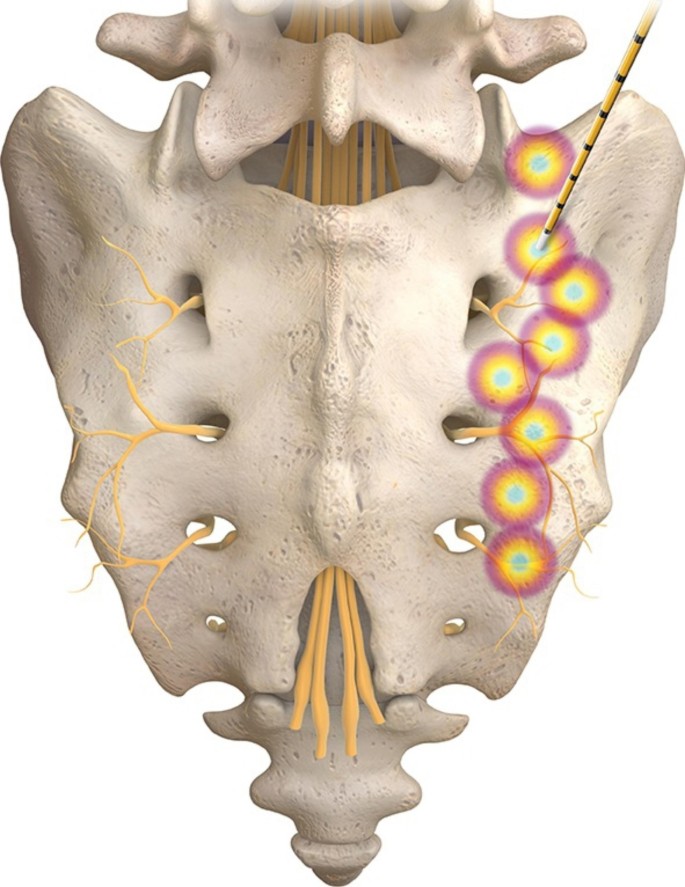Sacroiliac Joint Radiofrequency Ablation
Sacroiliac (SI) joint radiofrequency ablation is a minimally invasive treatment designed to provide long-term relief from chronic lower back or pelvic pain that originates from the SI joint. This joint connects the base of the spine to the pelvis and can be a significant source of discomfort when inflamed or irritated. By targeting the nerves responsible for transmitting pain from the SI joint, this procedure helps disrupt the pain pathway and restore function.
This outpatient treatment is typically recommended after a successful diagnostic injection confirms the SI joint as the source of pain. It’s a safe and effective option for patients who have not responded well to physical therapy, medications, or injections.

What is it?
Basivertebral nerve ablation is a minimally invasive procedure designed to treat chronic low back pain that originates from vertebral body endplates. This procedure specifically targets the basivertebral nerve, which carries pain signals from damaged or degenerated vertebrae.
How is it performed?
The procedure is performed under fluoroscopic (X-ray) guidance and typically takes 15-20 minute per level treated. Using precise imaging, your physician will guide a specialized probe through a small incision to reach the basivertebral nerve. Radio-frequency energy is then used to disable the nerve’s ability to transmit pain signals.
Technology Partners
Avanos’ Trident and Coolief, Boston Scientific, Abbot, Stryker’s Venom, Stratus Medical’s Nimbus
Keypoint #1-Lorem Ipsum
Lorem Ipsum mon fringilla dolor felis amet fusce.
• Libero auctor
• Enim molestie iaculis
• Massa bibendum
• Ultrices varius
Metus euismod tellus penatibus in ex morbi euismod mollis.
Phasellus venenatis augue luctus sollicitudin elementum suspendisse.
Treatment Benefits
Radiofrequency ablation can offer pain relief that lasts for several months by precisely disabling sensory nerves that contribute to SI joint discomfort. Benefits include improved mobility, reduced reliance on medications, and a better ability to engage in physical activity or rehabilitation. The procedure is image-guided, which ensures accuracy and minimizes risk.
Who Can Benefit From This Treatment
This treatment is often recommended for individuals with confirmed SI joint dysfunction who continue to experience pain despite conservative treatment. It’s especially helpful for patients with localized lower back or buttock pain that worsens with standing, walking, or transitioning between sitting and standing. A diagnostic nerve block is typically performed first to ensure the targeted nerves are the true source of the pain.
Learn more about Sacroiliac Joint Radiofrequency Ablation by contacting the Minimally Invasive Spine and Pain Institute—our team is here to help you explore your options.
Aftercare for Sacroiliac Joint Radiofrequency Ablation
After SI joint radiofrequency ablation, it’s common to experience mild soreness, swelling, or a sunburn-like sensation at the treatment site. These symptoms are typically temporary and resolve within a few days. While some patients feel relief right away, full benefits may take up to two weeks as the nerves respond to the treatment. Most people are able to return to light activity shortly after the procedure, but it’s important to avoid overexertion during the initial recovery period.
Tips for a Smooth Recovery
Follow these guidelines to support healing after sacroiliac joint radiofrequency ablation:
- Limit strenuous activity or twisting motions for the first 24–48 hours
- Use ice packs to manage localized swelling or discomfort
- Keep the injection site clean and dry until any tenderness resolves
- Resume walking and gentle movement to promote circulation and joint mobility
- Notify your provider if you experience increased pain, redness, or unusual symptoms

